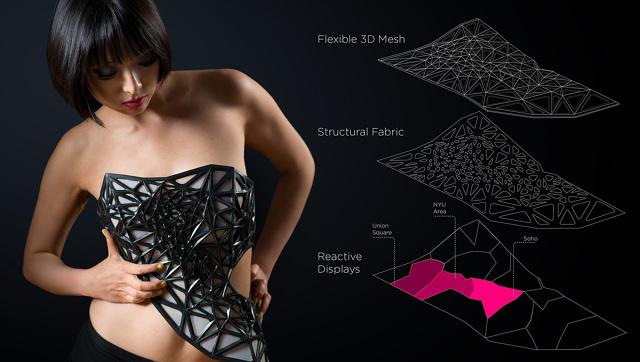Americans are obsessed with privacy, or at least we think we are. In fact, paradoxical privacy laws make it truly difficult sometimes for you to even access your own information, all the while allowing companies to access private information we generously, but unknowingly, sprinkle around the web. The invisibility of the ways in which the data mining is done leaves people with an over developed sense of safety. It is exactly that complacency with which this garment attempts to confront us.
Designers Xuedi Chen and Pedro Oliveira, students in the Interactive Telecommunications Program at New York University, created a wearable marker of the privacy lost when we cede information through use of smartphones and social media, for their thesis show. Chen began by regaining access to her own geospatial data, using Node.js and PhoneGap, and logging it over time. That information was then used to create an algorithm for pattern generation. She then pulled information from her data set, processed it and fed it into Rhino to create a 3D mesh. This mesh was then 3D printed using a flexible plastic to create the outer structure of the garment. This was then combined with a structural fabric and a reactive display material that makes up the innermost layer of the garment.
The openings in the mesh correspond with potential locations for the wearer, in this case New York City neighborhoods. As the wearer passively produces location data, a blue tooth device sends the information to an Arduino board, which in turn, controls the transparency of the garment’s display cells. As data is produced, revealing digital information, the display material becomes more transparent in related areas, revealing physical information. It’s hard to ignore the message behind this garment, even if Chen and Oliveira have positioned the creation as a reflection, rather than activism.
Unlike Janet Jackson’s unintentional (?) wardrobe malfunction, this “wearable data-driven sculpture” is specifically designed to demonstrate just how naked we are, even in the privacy of our own homes.
As Chen noted, “I have already ceded control of my data, I wanted to go a step further and broadcast it for anyone and everyone to see.”
Let us know what you think of this part art, part clothing, part technology piece of work in the X.Pose 3DPB.com forum thread. Check out the brief video below showing the dress off in more detail.
[Source: Xc-xd.com]Subscribe to Our Email Newsletter
Stay up-to-date on all the latest news from the 3D printing industry and receive information and offers from third party vendors.
You May Also Like
Gorilla Sports GE’s First 3D Printed Titanium Cast
How do you help a gorilla with a broken arm? Sounds like the start of a bad joke a zookeeper might tell, but it’s an actual dilemma recently faced by...
Nylon 3D Printed Parts Made More Functional with Coatings & Colors
Parts 3D printed from polyamide (PA, Nylon) 12 using powder bed fusion (PBF) are a mainstay in the additive manufacturing (AM) industry. While post-finishing processes have improved the porosity of...
$25M to Back Sintavia’s Largest Expansion of Metal 3D Printing Capacity Since 2019
Sintavia, the digital manufacturing company specializing in mission-critical parts for strategic sectors, announced a $25 million investment to increase its production capacity, the largest expansion to its operations since 2019....
Velo3D Initiates Public Offering in a Bid to Strengthen Financial Foundations and Drive Future Growth
Velo3D (NYSE: VLD) has been among a number of publicly traded 3D printing firms that have attempted to weather the current macroeconomic climate. After posting a challenging financial report for 2023,...


































